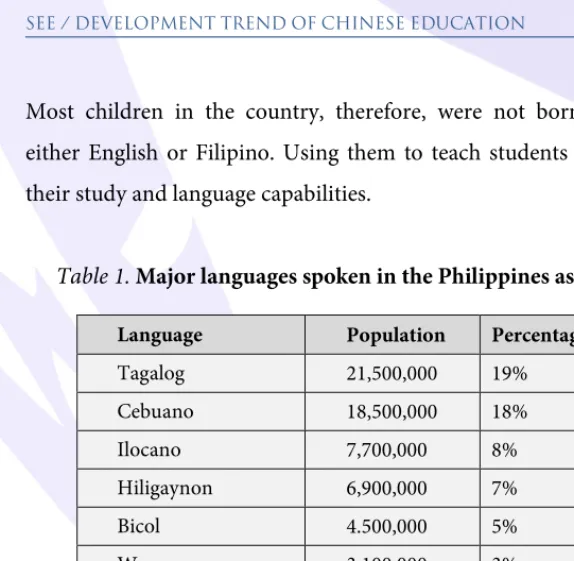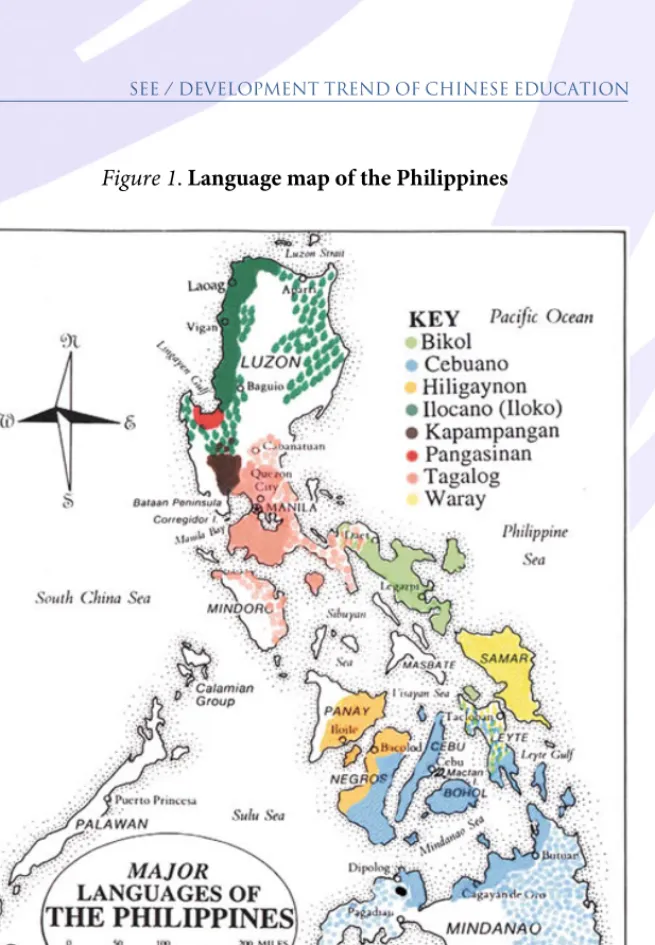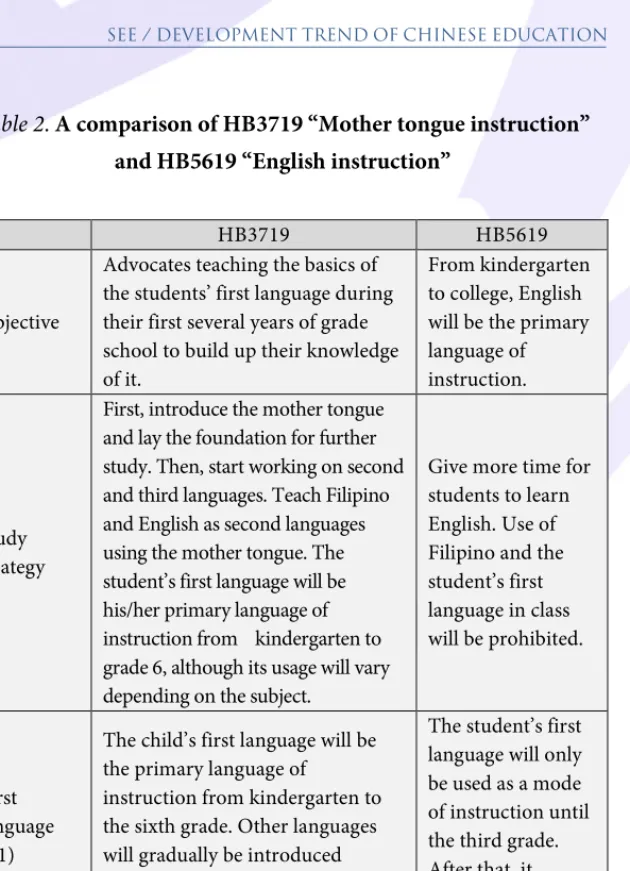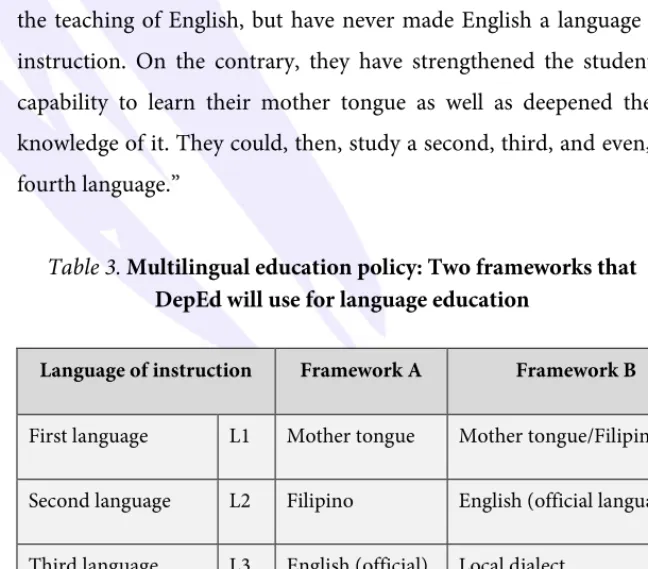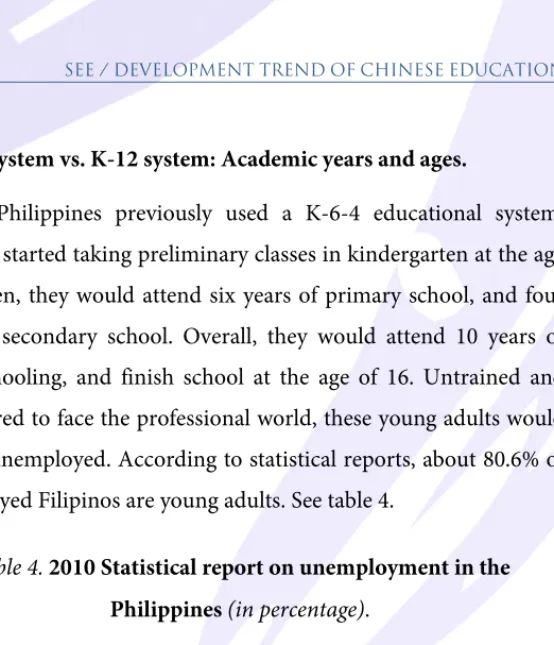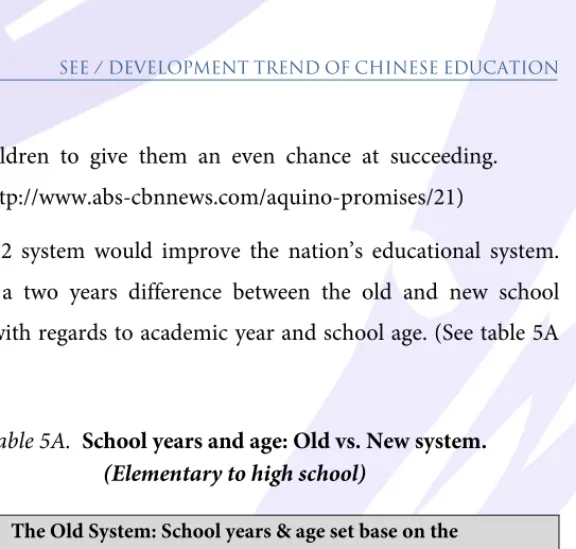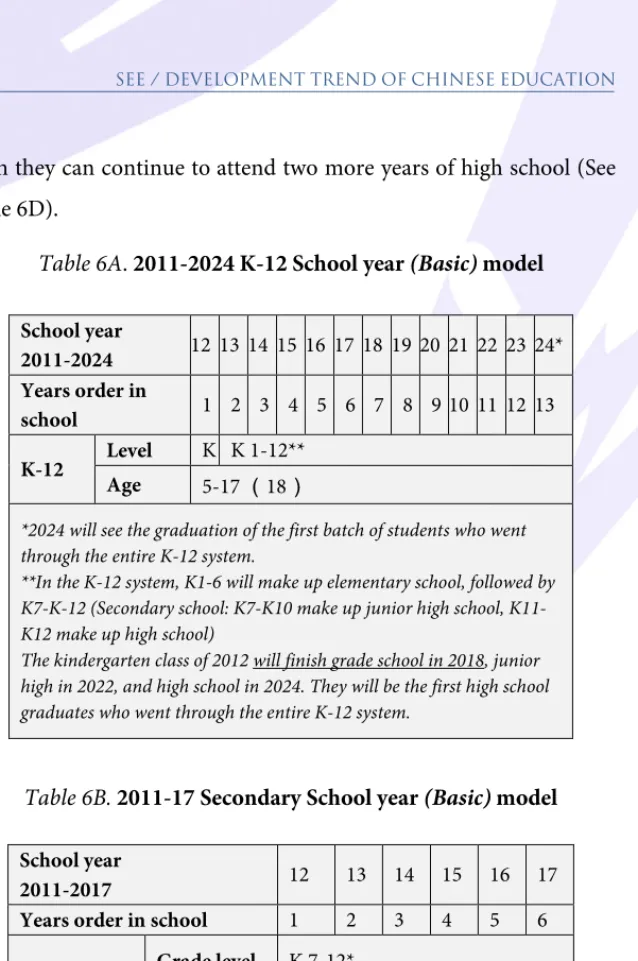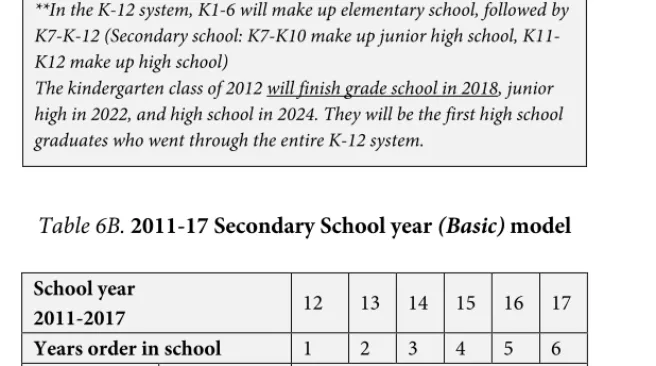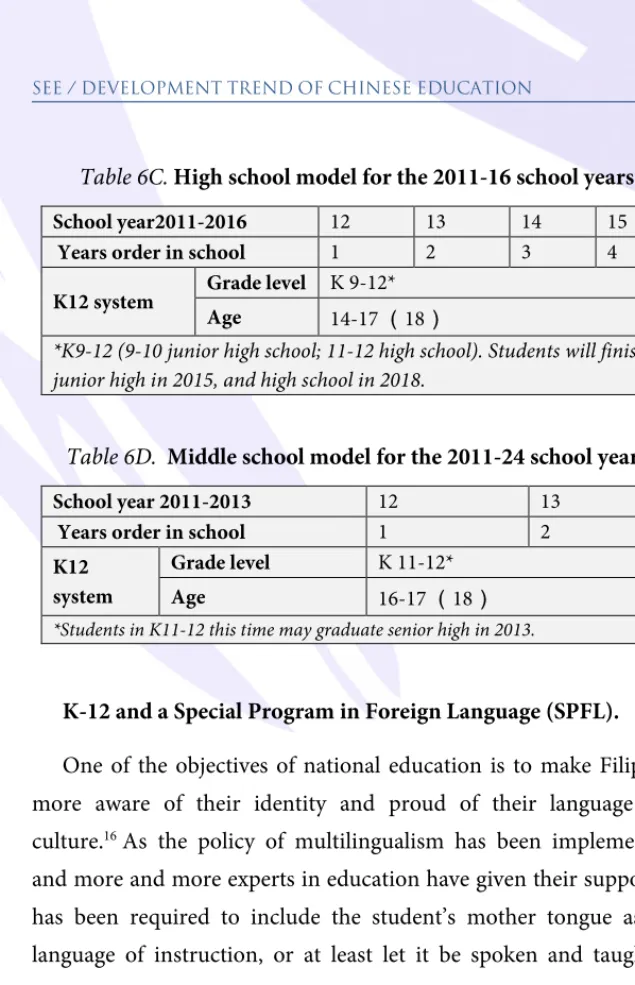CHINESE STUDIES PROGRAM LECTURE SERIES © Ateneo de Manila University No. 3, 2016: 56–103 http://journals.ateneo.edu
EXPLORING THE DEVELOPMENT TREND OF CHINESE EDUCATION
IN THE TERTIARY LEVEL (PHILIPPINES)
PROF.DAISYCHENGSEE
ABSTRACT
This paper traces the changes and developments in Chinese education in the Philippines by a survey of the history thereof. It discusses how Chinese education developed from an education catered to a small number of overseas Chinese to the ethnic Chinese, from an education of students of Chinese descent to mainstream Philippine society in the tertiary level, and the role played by the socio-political environment in this regard. This paper also seeks to answer the question of whether the policy of the Philippine government has anything to do with this development. Difficulties and obstacles to this type of education are discussed. Through an evaluation of the foregoing, this paper proposes some solutions to the perceived problems. This paper uses the investigative exploratory method of study. Books and relevant publications are utilized where necessary. Materials from the Internet from recognized institutions are also used as reference. Interviews and surveys were also conducted in the process of this study.
Keywords: Mandarin Linguistic routines; Digital storytelling, Communicative Approach
CHINESE STUDIES PROGRAM LECTURE SERIES © Ateneo de Manila University No. 3, 2016: 56–103 http://journals.ateneo.edu
hinese education in the Philippines refers to the education taught to ethnic Chinese who became Filipino citizens in Chinese schools after Filipinization.1 Chinese schools have already systematically turned into private Filipino schools that taught the Chinese language (Constitution of the Philippines, 1973).2 Basically, this so-called “Chinese-Filipino education” must have begun in 1976, when Chinese schools in the Philippines underwent comprehensive Filipinization. (Liu Jiansheng, 2012). This change meant the shift of Chinese schools from general Chinese education to mainly teaching the Chinese language. The main focus of these schools was no longer the overseas Chinese, but Chinese children who were now Filipino citizens (Liu JIansheng, 2012; Constitution of the Philippines, 1987; The Fifth Annual Report on Education in the Republic of China), ethnic Chinese, and even the very small minority of native Filipinos who attended these schools. Chinese education gradually shifted its focus to teaching the Chinese language and culture. (Sy, 2011) However, the schools that had this so-called Chinese education
1 During the administration of President Ferdinand Marcos, the new Filipino constitution that was ratified in 1973 stated, among others, its policy of Filipinizing Chinese schools.
2 Chinese Schools now had to register with the Philippine government. They were now under the jurisdiction of the Filipino government and had to comply with Philippine education laws. The government of the Republic of China no longer had any authority and jurisdiction over Chinese schools in the Philippines, and could no longer be involved with them. See (1987) The Fifth Annual Report on Education in the Republic of China. Taibei: Zhengshu Press. Pg.
1705.
C
CHINESE STUDIES PROGRAM LECTURE SERIES © Ateneo de Manila University No. 3, 2016: 56–103 http://journals.ateneo.edu
were all private schools, and not schools that represented mainstream society (Department of Education [DepEd] Statistics Report, 2011).3
At present, there are 2,180 tertiary schools all over the Philippines, 1,573 of which are private, which make up 72.16% of the total number of tertiary schools. The remaining 27.84% are all government-run universities (Table 1). As for Chinese education in tertiary schools in the Philippines, before Filipinization, Chiang Kai Shek College was the only institution of higher education in the Philippines that provided education for overseas Chinese (Palanca, 2004). In 1965, the university opened the departments for two four- year (Chinese education) college courses — Bachelor’s degree in Education, and Bachelor’s degree in History and Literature. The following year, it began to offer business courses, with majors in accounting, banking, finance, and others. Until 1976, after Filipinization, schools around the country strictly operated in accordance with the Department of Education’s standards. In 1992, Chiang Kai Shek College opened its computer science department.
That same year, it started offering two-year college preparatory courses, as well as electives in education, literature, and history. After
3 There are a total of 45, 964 schools in the Philippines, among which, public schools make up 83.44%, and private schools make up 16.56%. The total number of secondary schools in the Philippines in 12, 950, 56.12% of which are public schools, while 43.88% of which are private.
Comparatively speaking, schools that provide Chinese education basically make up less than 1% of schools in the country.
CHINESE STUDIES PROGRAM LECTURE SERIES © Ateneo de Manila University No. 3, 2016: 56–103 http://journals.ateneo.edu
Filipinization, education in Chiang Kai Shek College’s undergraduate school also began to change. In 1976, the education, literature, and history departments all persisted. The teachers were all specialized professors sent by Taiwan, but because of enrolment issues, there were not a lot of students. Later, the college underwent comprehensive reforms. In both the new and old specialized courses, the business, and computer science courses, were all taught in English and Filipino. Only several required courses on the Chinese language and culture were offered.
Reforms and renovations in the Filipino educational system in the 70s also marked a new chapter in the history of Chinese-Filipino education. As a matter of fact, the writer, herself, witnessed and experienced the changes that swept Chinese education in the Philippines. Therefore, this paper shall trace the development of Chinese education in the Philippines and how it gradually extended to tertiary schools. It shall explain how the focus of Chinese education shifted from solely the small number of Chinese expatriates, including ethnic Chinese, and its growing role in ethnic Chinese society, and eventually, to its inclusion in mainstream society. What did this turning point mean for Chinese and mainstream Filipino society? Did Chinese education encounter any obstacles in joining mainstream society? Was there a direct relationship between the direction the development of Chinese education was taking and the government? What measures were
CHINESE STUDIES PROGRAM LECTURE SERIES © Ateneo de Manila University No. 3, 2016: 56–103 http://journals.ateneo.edu
taken to overcome these obstacles? Could the development of Chinese tertiary education bridge the gap between China and the Philippines? By looking back on the history of Chinese tertiary education, the writer shall provide a logical and detailed assessment of the trend of Chinese tertiary education. The writer hopes that the findings of this paper may benefit the future development of Chinese higher education in the Philippines.
The Philippine Educational System
Historical background and the educational system.
Throughout history, there has always been a very close relationship between a certain culture and education. The Philippine educational system has undergone numerous stages. Ever since pre- Hispanic times when many traders from India and China would come to the country to do business, cultural diffusion has been inevitable. But no standardized educational system existed until 1571, when Spain formally colonized the Philippines. Education in the Philippines was, for the first time, standardized under Spanish colonial rule. The difference between pre-Hispanic and Hispanic education was enormous. The main purpose of the now-standardized educational system under Spanish rule was to propagate the Catholic faith. Schools were the centers used to spread the faith, provide education, and maintain the peace
黄淑玲
, (2006). However, this kindCHINESE STUDIES PROGRAM LECTURE SERIES © Ateneo de Manila University No. 3, 2016: 56–103 http://journals.ateneo.edu
of education was not available to everyone. Feudalism ran deep under this system. Peasants could barely afford schooling. The system mainly catered to the upper class. It was a long-term project undertaken solely for the wealthy. Of course, behind the scenes, there must have been political reasons for this as well. Furthermore, education itself was not a simple undertaking. Problems arose regarding students, teachers, the curriculum, schools, scale of administration, practical experience, exercise, funding, etc.
In 1863, the Philippine Bureau of Education ordered that an investigation be conducted on how to expand primary education, and also called for the establishment of a public school system (
冯增
俊
, 2002, p. 314). Two years later, as the board of education voted to implement reforms in the educational system, it decreed that every district build public schools for boys and girls. Free education was to be given to children ages 7-12. Furthermore, this decree allowed Filipinos and those of mixed heritage to receive higher education. As education spread throughout the country, a Filipino intelligentsia grew day by day. As a result, Philippine education underwent a new period of institutionalization. There were now primary and secondary schools, as well as vocational schools, and universities. In 1898, after Spain’s defeat in the Spanish-American War, the Spaniards were forced to give up the Philippines to the United StatesCHINESE STUDIES PROGRAM LECTURE SERIES © Ateneo de Manila University No. 3, 2016: 56–103 http://journals.ateneo.edu
of America (Treaty of Paris, 1898).4 The Philippines became America’s colony. From the very beginning, the Americans knew that they could not use military force to subjugate the Filipinos, who desired independence. America had to foster a pillar of colonial society that taught Filipinos to become loyal subordinates of America
(周庆,
1997). So, they launched a heavy campaign to “assimilate”the Filipinos. This so-called “assimilation” was actually
“Americanization.” The United States sent a big wave of American teachers known as the Thomasites, who used American-style politics, economics, laws, culture and other aspects to educate the Filipinos and turn them into loyal subjects of America. At the same time, America’s Americanization policy also allowed some “Filipinization”
in the Philippine government. They knew that establishing a colonial education system was a good way to pacify Filipino resistance, as well as to bring peace in the country. Thus, all American military bases had schools as well as English teachers. Two years later, the American military had built 1,000 schools, with the number of students close to 100,000.5 As American-style education spread, the number of students and American teachers also grew. English naturally became the language taught in schools. Later, the Filipino
4 Treaty of Paris, December 10,1898. Treaty of Peace between USA and Spain. Retrieved May 1, 2009 from http://avalon.law.yale.edu/ 19th_century/sp1898.asp
5 Act No. 74 and 525. Education Act of 1901 and 1902.
CHINESE STUDIES PROGRAM LECTURE SERIES © Ateneo de Manila University No. 3, 2016: 56–103 http://journals.ateneo.edu
colonial government was allowed to establish state-funded exchange student program (Pensionado Act, 1903).6 The goal of education was to lead the Filipino people into a life of democracy.
The contrasts between Spain and America’s policies were directly felt by the Filipinos. Whereas before, only those of the aristocratic class could speak Spanish, which separated them from most of the population, now, almost all Filipinos knew English. How could Filipinos not embrace this change? English was not just the language used in schools; it was the language spoken by practically all of Filipino society. The colonial government continued to develop the education system and its policies. It ordered for public schools to be built all around the country, gradually spreading public education. At the same, private education was similarly on the rise as the American colonial government allowed the establishment of more private schools. Inevitably, as more private schools were founded, those that catered to ethnic minorities were also built.7 Other than the fact that in both private and public Chinese schools, afternoon classes were all taught in Chinese; they were basically the same as all the other schools, with the primary language of instruction being American English. By 1945, American culture was everywhere in the entire
6 The 1903 Pensionado Act, or Act 854, which was signed by then-Governor General, William Howard Taft, allowed qualified Filipino students to pursue four-year undergraduate studies in the United States.
7 In 1899, the first Chinese school in the Philippines, the Philippine Tiong Se Academy, was founded. Chinese was the language used to educate overseas Chinese in the Philippines.
CHINESE STUDIES PROGRAM LECTURE SERIES © Ateneo de Manila University No. 3, 2016: 56–103 http://journals.ateneo.edu
nation. There were also more schools, both private and public, that catered to certain nationalities.
Things changed in 1942, when the Japanese empire invaded the Philippines. Japanese educational policies decreed that English be replaced with Japanese as the new medium of instruction.
Elementary schools were integrated with vocational training schools in order to create a major source for manual and technical labor (Tulio, 2008). Both countries were enveloped in an ongoing struggle, and battles were fought in many parts of the country. This would go on until 1945, when the Philippines, with the aid of the United States, finally won their freedom. Since then, America has continued to have a profound and lasting influence on the country. Overall, the design and development of the educational system in the Philippines has been mostly influenced by Spain8 and the United States.9
Teaching bridge languages and foreign languages.
As previously explained, the biggest influences in language education in the Philippines were Spain and the United States of America. During the Spanish colonial period, Spanish was used as the language of instruction. Because education was not universal, the
8 Numerous private Catholic schools were founded. The curriculum centered mostly on religion.
9 English was introduced in schools. Every aspect of life in the country---from the government to education---emulated the United States.
CHINESE STUDIES PROGRAM LECTURE SERIES © Ateneo de Manila University No. 3, 2016: 56–103 http://journals.ateneo.edu
only ones who could read and write Spanish were members of the upper class.10 When the Americans arrived, Spanish and English became the official languages. Other than the fact that English was now the international lingua franca, it was not by chance that English had now become an official language of the Philippines. This all has to do with the nation’s government, officials, educational system, and history.
America carefully implemented an American-style educational system in the entire country, in an effort to Americanize the Philippines. Thousands of English teachers were sent, and the educational system was centralized. Volunteer teachers from the US were used to create an American-style public school system. On the surface, the Americans seemed to encourage and train the Filipinos to be more independent. But in reality, it was all to keep them in line and maintain America’s influence in the country. The Americans had no intention in relinquishing their hold on the Philippines. However, the Filipinos were able to completely improve their educational system. The idea that basic compulsory education should be implemented in the country was introduced. The policies and actions taken by the colonial government were basically the same as those
10 From 1571-1987, Spanish was one of the official languages of the colony. Strictly speaking, it was not spoken by everyone but members of the elite and the intelligentsia. Only those who went to school learned it. As a matter of fact, until the ratification of the 1987 Constitution, Spanish was a required subject in schools. Now, it is only an elective.
CHINESE STUDIES PROGRAM LECTURE SERIES © Ateneo de Manila University No. 3, 2016: 56–103 http://journals.ateneo.edu
that America’s public school system used. Through America’s attempt in turning the Filipinos into its loyal subjects through Americanization, English naturally became a Filipino language. It was not just used as the language of instruction, but was also used by many people in everyday life. This phenomenon was everywhere. It heavily influenced the thoughts of the Filipinos, and almost even made them forget their own identity, as the nationwide spread of English impeded the development of the nation’s native culture and languages (
周庆,
1997). Filipinos could not escape American culture’s influence in every aspect of life, whether it was politics or education. For the next several decades, the government made several attempts in promoting the native languages as the means of instruction,11but none succeeded. More importantly, most public officials, congressmen, and representatives, by now, had been Americanized. Unfortunately, due to persistent bickering, it was now more difficult to pass legislation to solve this. English, just as before, remained as the only official language, as well as the language used in mainstream society. This would go on until 1973, when the Philippine government declared that both Filipino and English would become the nation’s official languages. Both were to be used in classes in Filipino schools (Constitution of the Philippines, 1973). To this day, there is still controversy over the issue of language11 See Senate draft bills 1563、162、3719、1138、5619.
CHINESE STUDIES PROGRAM LECTURE SERIES © Ateneo de Manila University No. 3, 2016: 56–103 http://journals.ateneo.edu
education. Filipino intellectuals want to promote the use of English over the mother tongue. However, in certain circumstances—such as, when dealing with people who live in remote and rural areas, as well as small villages, or the lack of teachers— there is actually no other option but to use Filipino or the local dialects.
Bilingual education policy.
All schools, whether private or public, have to follow the standards set by the Department of Education (DepEd). The “English first, Filipino second” policy continued until 1976 when schools all over the nation underwent “Filipinization.” Before, other than following the standards set by the DepEd, private foreign schools such as Spanish, Indian, Japanese, and Chinese schools used their native language to teach their classes. At the time, such schools were centered on the culture of their respective ethnic groups (
汪土星
: 17)12.Therefore, the policy of bilingual education (English-Filipino, English-Chinese, etc.) was not a completely novel idea.
When the Philippines was under Martial Law (1974), Filipinos, for the first time, formally had the following subjects taught in their
12 According to James Hijiya, ancestry, homeland, and blood ties are the main factors in identifying a group’s common identity. At the time, Filipinos of foreign ancestry built schools that followed this concept, and so, used their native language as the language of instruction.
CHINESE STUDIES PROGRAM LECTURE SERIES © Ateneo de Manila University No. 3, 2016: 56–103 http://journals.ateneo.edu
mother tongue: social science, arts and music, physical education, home economics, practical arts, and character education, all towards promoting nationalism. In 1976, foreign languages other than English could only be taught and used in schools as a second language. However, English was still used in classes such as science, math, and technology. The nationalist movement made Filipinos more focused on their own race, and the Filipino language was promoted throughout the country. The implementation of a Filipino-English bilingual policy became more and more evident, but it was always one-sided.
During President Gloria Macapagal Arroyo’s term, schools reaffirmed the government’s bilingual education policy (Article 14, section 7 of the 1987 Constitution). As an economist, President Arroyo observed the decline in proficiency in the English language among Filipinos, and worried that they would lose their competitive advantage in the international labor market, which would then affect the country’s economy. So, she considered advocating English as the primary language of instruction, although she never ignored the importance of the Filipino language, and promoted its use in other classes. This meant that English would be used in all the important courses, while Filipino would be used in secondary courses. In the first two years of elementary school, students were to be taught using Filipino or their local dialects for several reasons. First, this would
CHINESE STUDIES PROGRAM LECTURE SERIES © Ateneo de Manila University No. 3, 2016: 56–103 http://journals.ateneo.edu
make it easier for students to learn common sense, understand their basic responsibilities and duties as citizens, learn their cultural values, as well as music and arts. Second, this would make students more interested in further studying. Difficult subjects like English, natural science, and math would gradually be introduced in the curriculum, until classes would primarily be taught in English.
Actually, this was just a case of history repeating itself. As the students started attending tertiary schools, they started using English more than Filipino. In reality, the primary language of instruction was now English. All college courses were taught in English. Filipino was only used for primary education.
From the beginning, this paradoxical situation has led to endless controversy. The more the country embraced an “English first”
policy, the more that “independence” meant further Filipinization of education. The coexistence of a policy of promoting English in education and Filipinization seemed very illogical. Nationalists claim that Filipinos must first learn from their own culture, and learning their language is the most basic requirement. But to achieve this goal, one question should be answered. Which should become the national language to be used as the primary language of instruction, the Filipino language, or one of the nation’s dialects? This was the subject of much controversy in the past (Section 6 of the 1987 Constitution; Magbantay, 2012). English could only be spoken in schools as a second language.
CHINESE STUDIES PROGRAM LECTURE SERIES © Ateneo de Manila University No. 3, 2016: 56–103 http://journals.ateneo.edu
This debate over language—involving the subject of patriotism and competitive advantage in the global market—led to the Philippines’ bilingual policy. Implementation of this policy has been a cause for concern for many experts in education, psychology, and language. Some experts believe that teaching Filipino as a second language again is the best solution. They believe that teaching both languages would lead to bastardization of both Tagalog and English.
Filipinos would be unable to speak both English and Filipino properly, and only have a shallow understanding of both languages (Constantino, 2000). This debate persists to this day. Even though the bilingual policy is already in place, there are those who question the Philippines’ use of English and Filipino in classes, as well as those who debate over which should be used as the language of instruction in the country—Filipino, one of the dialects, or English. Until now, the search for the best language of instruction continues.13
Multilingual education.
The Philippines is a multilingual nation, with over 170 languages across the country. Among these many languages, Tagalog is the most widely spoken, with its speakers making up 19% of the country’s population. Table 1 shows the major languages spoken.
13 It is important to mention all language specialists in the country who studied this problem such as Drs. Andrew Gonzalez and Bonifacio Sibayan.
CHINESE STUDIES PROGRAM LECTURE SERIES © Ateneo de Manila University No. 3, 2016: 56–103 http://journals.ateneo.edu
Most children in the country, therefore, were not born speaking either English or Filipino. Using them to teach students may harm their study and language capabilities.
Table 1. Major languages spoken in the Philippines as of 2000
Language Population Percentage
Tagalog 21,500,000 19%
Cebuano 18,500,000 18%
Ilocano 7,700,000 8%
Hiligaynon 6,900,000 7%
Bicol 4.500,000 5%
Waray 3,100,000 3%
Kapampangan 2,300,000 2%
Pagansinan 1,500,000 1.5%
Kinaray-a 1,300,000 1.3%
Tausug 1,000,000 1%
Meranao 1,000,000 1%
Maguindanao 1,000,000 1%
CHINESE STUDIES PROGRAM LECTURE SERIES © Ateneo de Manila University No. 3, 2016: 56–103 http://journals.ateneo.edu
Figure 1. Language map of the Philippines
Source: http://www.thinkphilippines.com/pictures/philippines_language_map.jpg
CHINESE STUDIES PROGRAM LECTURE SERIES © Ateneo de Manila University No. 3, 2016: 56–103 http://journals.ateneo.edu
It is clear that the Philippine school system’s bilingual education policy has betrayed the children’s basic right to education (United Nations Convention on the Rights of Children, 1990). If the children are not taught using their mother tongue (the language that they speak at home), then, the government is taking away their right to receive an education. Experts who have studied this problem, stressed that teaching children using their mother tongue is a major factor in improving their learning, and thus, promoted the implementation of a multilingual policy. The United Nations and experts from around the globe support multilingualism. The entire world supports each nation’s right to retain its own unique, rich language and culture. Therefore, a “mother tongue instruction”
policy is seen as a “means of improving educational quality by building upon the knowledge and experience of the learners and teachers” (UNESCO, 2003). Later, the Philippine House of Representatives unanimously passed House bills, 3719 and 5619.
Both became the source of comparisons, studies, and debates. Table 2 provides a comparison of the two bills.
CHINESE STUDIES PROGRAM LECTURE SERIES © Ateneo de Manila University No. 3, 2016: 56–103 http://journals.ateneo.edu
Table 2. A comparison of HB3719 “Mother tongue instruction”
and HB5619 “English instruction”
HB3719 HB5619
Objective
Advocates teaching the basics of the students’ first language during their first several years of grade school to build up their knowledge of it.
From kindergarten to college, English will be the primary language of instruction.
Study strategy
First, introduce the mother tongue and lay the foundation for further study. Then, start working on second and third languages. Teach Filipino and English as second languages using the mother tongue. The student’s first language will be his/her primary language of instruction from kindergarten to grade 6, although its usage will vary depending on the subject.
Give more time for students to learn English. Use of Filipino and the student’s first language in class will be prohibited.
First language (L1)
The child’s first language will be the primary language of
instruction from kindergarten to the sixth grade. Other languages will gradually be introduced afterwards. (Secondary to tertiary school)
The student’s first language will only be used as a mode of instruction until the third grade.
After that, it cannot be used in classes anymore.
Adopting English
Make English an important subject in primary school. Other subjects will gradually adopt English and Filipino as secondary languages of instruction. (Until secondary school)
After the third grade, gradually start using English as the primary mode of instruction.
CHINESE STUDIES PROGRAM LECTURE SERIES © Ateneo de Manila University No. 3, 2016: 56–103 http://journals.ateneo.edu
Adopting Filipino
Make Filipino an important subject in primary school. Other subjects will gradually adopt English and Filipino as secondary languages of instruction. (Until secondary school)
The student’s first language will only be taught until the third grade. After that, it will only be used as an intermediary language.
Time limit for teaching Filipino/
English
From grades 4-6, English and Filipino will be used to teach certain elementary school subjects as secondary languages of
instruction.
No time limit. All classes are to be taught in English.
Curriculum development
Constant development for the student’s first, second, and third languages.
No curriculum for the student’s first and second language. Only the student’s third language (English) will have a curriculum.
Teachers’
training
Constant development for the teachers teaching the student’s first, second, and third languages.
No teachers for the student’s first and second languages, only the third (English). English will be the sole medium of language instruction.
CHINESE STUDIES PROGRAM LECTURE SERIES © Ateneo de Manila University No. 3, 2016: 56–103 http://journals.ateneo.edu
The Philippine DepEd Secretary then, Jesli Lapus, later announced his stance; “We find the bill (the Gunigundo bill) to be consistent with the Basic Education Sector Reform Agenda (BESRA) recommendations and the bridging model proposed by the Bureau of Elementary Education where pupils were found to comprehend better the lessons in class.” (Nolasco, 2009). The objective of the policy of multilingualism is also to improve the quality of education the students receive (DepEd Order 74, 2009). The DepEd would introduce two frameworks for language education, A and B. Students would have to study at least three languages. In framework A, the student’s first language would be their mother tongue (L1), their second language would, then, be Filipino (L2), and their third language would be the official language, which would be English (L3). As for framework B, the first languages would be the student’s mother tongue and Filipino (L1), the second language would be the official language, English (L2), the third language would be the local dialect (L3), and the fourth language would be any foreign language other than English (See table 3).
After Gunigundo’s explanation, the head of the National Economic Development Authority (NEDA) then, Ralph Recto, stated his support for the bill but also called for several additions that would solve other problems, such as the high drop-out rate, slow learning rate, and the low efficiency problems faced by schools. This would increase the rate of attendance in schools in the Philippines,
CHINESE STUDIES PROGRAM LECTURE SERIES © Ateneo de Manila University No. 3, 2016: 56–103 http://journals.ateneo.edu
strengthen language learning, and remove further obstacle. In summary, passing this bill would be beneficial for the nation’s economic and financial position. As support for this policy grew, former head of the Department of Education, Edilberto de Jesus, said, “Every nation in the world has invested billions in promoting the teaching of English, but have never made English a language of instruction. On the contrary, they have strengthened the student’s capability to learn their mother tongue as well as deepened their knowledge of it. They could, then, study a second, third, and even, a fourth language.”
Table 3. Multilingual education policy: Two frameworks that DepEd will use for language education
Language of instruction Framework A Framework B
First language L1 Mother tongue Mother tongue/Filipino
Second language L2 Filipino English (official language)
Third language L3 English (official) Local dialect
Fourth language L4 Foreign language
CHINESE STUDIES PROGRAM LECTURE SERIES © Ateneo de Manila University No. 3, 2016: 56–103 http://journals.ateneo.edu
Old system vs. K-12 system: Academic years and ages.
The Philippines previously used a K-6-4 educational system.
Students started taking preliminary classes in kindergarten at the age of 6. Then, they would attend six years of primary school, and four years of secondary school. Overall, they would attend 10 years of basic schooling, and finish school at the age of 16. Untrained and unprepared to face the professional world, these young adults would end up unemployed. According to statistical reports, about 80.6% of unemployed Filipinos are young adults. See table 4.
Table 4. 2010 Statistical report on unemployment in the Philippines (in percentage).
Description Percent Total
15-24 years old 51.5%
80.6%
25-34 years old 29.1%
High school graduate 33.1%
70.9%
College graduate 19.3%
Finished graduate studies 18.5%
CHINESE STUDIES PROGRAM LECTURE SERIES © Ateneo de Manila University No. 3, 2016: 56–103 http://journals.ateneo.edu
However, the literacy rate in the Philippines is 93%.14 As the current chair of the Commission on Higher Education, Dr.
Patricia Licuanan, said, even though Filipinos could speak and write in English, relying on language is not enough to solve the nation’s poverty crisis15 (Nolasco, 2009). A high literacy rate alone cannot improve the country’s economy and the people’s standard of living.
Given these problems, it is hard to trust the school system, and many surveys were conducted about them.
Philippine President Benigno Aquino Jr. has stressed the importance of improving the quality of education in the country. The nation’s economy and future rest on building a strong foundation for the education of its citizens. Therefore, he called for reform in the school system.
We need to add two years to our basic education. Only those who can afford to pay for up to 14 years of schooling before university can send their children into the best universities and eventually, the best jobs after graduation. I want at least 12 years for our public school
14 http://www.indexmundi.com/map/?v=3908052012
15 Former dean of Miriam College and current chief of the Commission on Higher Education, Dr. Patricia Licuanan: “Teaching English cannot solve the problem of poverty in this country. In fact, it is probably one of the causes of poverty. A Mother Tongue policy would not only improve the quality of education in our nation, but may even be used as an effective tool to teach English.”
CHINESE STUDIES PROGRAM LECTURE SERIES © Ateneo de Manila University No. 3, 2016: 56–103 http://journals.ateneo.edu
children to give them an even chance at succeeding.
(http://www.abs-cbnnews.com/aquino-promises/21)
A K-12 system would improve the nation’s educational system.
There is a two years difference between the old and new school systems with regards to academic year and school age. (See table 5A and 5B)
Table 5A. School years and age: Old vs. New system.
(Elementary to high school)
The Old System: School years & age set base on the Education act 1982 & RA10157.
In school 1 2 3 4 5 6 1 2 3 4 1 2 3 4 5 6 Old
System
Level Primary 1-6 Secondary 1-4
Tertiary/
Undergrad (4-6)
Age 6-12 12-16 16-20 (22)
Table 5B. President Aquino Jr.’s K12 system (took effect on June 2011)
In
school 1 2 3 4 5 6 7 8 9 10 11 12 1 2 3 4 5 6
K12
Level K-12 Undergraduate
Courses (4-6)
Age 5-17(18) 19-22(24)
CHINESE STUDIES PROGRAM LECTURE SERIES © Ateneo de Manila University No. 3, 2016: 56–103 http://journals.ateneo.edu
Preparation of the School Year and Language Education Under the K-12 System
K-12 system’s module for one academic year.
DepEd Assistant Secretary, Elena Ruiz, explains that the K-12 system is one of President Aquino’s reforms, the goal of which is to improve the standard of living by improving the quality of education in the country. Actually, this system is a culmination of findings that education experts have made in the past. Another one of its objectives is to face the challenge of globalization. And so, during the 2011-12 school year, the DepEd formally implemented the new K-12 educational system. Following this policy (See table 6A), the first batch of students to complete the K-12 system should graduate from college in 2024. The first batch of grade school students would graduate in 2018, and the first batch of high school students would graduate in 2022. First year high school students in the 2011-12 school year will continue school for two additional years, and will graduate in 2017. (See table 6B)
The time period when the K-12 policy will be implemented could change by following the basic plan. For example, starting in the 2011- 12 school year, there would be two years of junior high (which was already high school in the previous system), followed by two years of high school (See table 6C). At the same time, i.e. if high school students in the 2011-12 school year are not ready to go to college,
CHINESE STUDIES PROGRAM LECTURE SERIES © Ateneo de Manila University No. 3, 2016: 56–103 http://journals.ateneo.edu
then they can continue to attend two more years of high school (See table 6D).
Table 6A. 2011-2024 K-12 School year (Basic) model
School year
2011-2024 12 13 14 15 16 17 18 19 20 21 22 23 24*
Years order in
school 1 2 3 4 5 6 7 8 9 10 11 12 13 K-12 Level K K 1-12**
Age 5-17 (18)
*2024 will see the graduation of the first batch of students who went through the entire K-12 system.
**In the K-12 system, K1-6 will make up elementary school, followed by K7-K-12 (Secondary school: K7-K10 make up junior high school, K11- K12 make up high school)
The kindergarten class of 2012 will finish grade school in 2018, junior high in 2022, and high school in 2024. They will be the first high school graduates who went through the entire K-12 system.
Table 6B. 2011-17 Secondary School year (Basic) model
School year
2011-2017 12 13 14 15 16 17
Years order in school 1 2 3 4 5 6
K12 system Grade level K 7-12*
Age 5-17 (18)
*K7-12 (7-10 make up junior high school; 11-12 make up high school).
They will finish junior high in 2015, and senior high school in 2017.
CHINESE STUDIES PROGRAM LECTURE SERIES © Ateneo de Manila University No. 3, 2016: 56–103 http://journals.ateneo.edu
Table 6C. High school model for the 2011-16 school years
School year2011-2016 12 13 14 15
Years order in school 1 2 3 4
K12 system Grade level K 9-12*
Age 14-17 (18)
*K9-12 (9-10 junior high school; 11-12 high school). Students will finish junior high in 2015, and high school in 2018.
Table 6D. Middle school model for the 2011-24 school years
School year 2011-2013 12 13
Years order in school 1 2
K12 system
Grade level K 11-12*
Age 16-17 (18)
*Students in K11-12 this time may graduate senior high in 2013.
K-12 and a Special Program in Foreign Language (SPFL).
One of the objectives of national education is to make Filipinos more aware of their identity and proud of their language and culture.16 As the policy of multilingualism has been implemented, and more and more experts in education have given their support, it has been required to include the student’s mother tongue as the language of instruction, or at least let it be spoken and taught in
16 Former president of the University of the Philippines and current superintendent of education, Jose V. Abueva: “We must use the local languages as the official languages of instruction, at least in grade school. The Filipino must be aware of their identity, so that he may learn about and be proud of our rich languages and cultures.”
CHINESE STUDIES PROGRAM LECTURE SERIES © Ateneo de Manila University No. 3, 2016: 56–103 http://journals.ateneo.edu
grade school. Dr. Michael Tan, the head of the University of the Philippines’ Department of Arts and Literature said,
We should allow Filipinos to nurture their own mother language and share this with other Filipinos or even the world. As we begin to appreciate the rhythms and cadences, the humor and the wisdom, in each of our many languages, we just might be able to overcome our parochialism and regionalism and build a nation strong in its multicultural foundations.
The K-12 system works well with the multilingual education policy set by Republic Act 3719. After finishing the first few years of school, students can immediately study four different languages. (See table 7)
Table 7. K-12 Language Education Plan
K12 L3 L4 L2 L1
K11 L3 L4 L2 L1
K10 L3 L4 L2 L1
K9 L3 L4 L2 L1
K8 L3 L4 L2 L1
K7 L3 4th Language L4* L2 L1
K6 L3 L2 L1
K5 L2 3rd Language L3 L1
K4 L2 L1
K3 L1 2nd Language L2
K2 L1
K1 L1
K Mother tongue-L1
*4th Language L4: Foreign, eg. Spanish, German, French, Japanese, and Chinese.
CHINESE STUDIES PROGRAM LECTURE SERIES © Ateneo de Manila University No. 3, 2016: 56–103 http://journals.ateneo.edu
The Department of Education: Secondary level.
This year, on July 25-27, DepEd Secretary Br. Armin Luistro FSC, through the Bureau of Secondary Education (BSE), hosted the 5th Language Conference for Implementers of the Special Program in Foreign Language (SPFL), inviting heads of language centers from around the world, foreign language experts, and teachers. These language institutions include the Instituto de Cervantes de Manila, Alliance Francaise de Manille, Japan Foundation Manila, Goethe Institute, and the Confucius Institute at the Angeles University Foundation. The conference’s objective was to “orient the implementers of the foreign language program under the K-12 basic educational system” (DepEd Memo 122: s.2012).
Deans and teachers from 136 schools participated in the conference. Seventeen SPFL regional coordinators, five Higher Education Institutions, and program partners also joined them. They discussed the SPFL’s past, present, and future, and debated one question: How could they continue to promote foreign language education in the country?
SPFL will be implemented in the curriculum under the K-12 system to give students more opportunities to find work abroad, by teaching them foreign languages. This course plan will be composed of three items, one of which is the one shown in Table 7. Foreign languages will be included in the report card along with other
CHINESE STUDIES PROGRAM LECTURE SERIES © Ateneo de Manila University No. 3, 2016: 56–103 http://journals.ateneo.edu
subjects.17 This may put pressure on the students but may also even encourage them. Other than that, there are still plans 2 and 3, where foreign languages will only be taught in high school. (See table 8) Due to the plan’s particular nature, it is a necessary requirement for teachers and students to follow. (See DepEd Order 31; s.2012).
Table 8. Possible plans for foreign language courses
Plan 1 Plan 2 Plan 3 Notes
K12 L4 Immersion L4 Intermediate L4 Basic
Plan 1/2: 240 minutes per week.
Plan 3: 900 minutes per week.
K11 L4 Intermediate L4 Intermediate L4 Basic K10 L4 Intermediate L4 Basic
K9 L4 Intermediate L4 Basic K8 L4 Basic
K7 L4 Basic
The Present Situation of SPFL (special programs in foreign language) in Public Schools
According to DepEd, the number of public schools with foreign language programs is steadily increasing. Over a hundred public high schools have started, with most schools offering Spanish (65 schools), followed by Chinese (32 schools), Japanese (21 schools), French (13 schools), and German (9 schools). Other than the Japanese and
17 K-7,L4, Foreign Language (Basic) 1; K-8, L5, Foreign Language (Basic) 2; K-9,Foreign Language (Intermediate) 1; K-10, Foreign Language (Intermediate) 2; K-11, Foreign Language (Intermediate) 3; K-12 Foreign Language Immersion.
CHINESE STUDIES PROGRAM LECTURE SERIES © Ateneo de Manila University No. 3, 2016: 56–103 http://journals.ateneo.edu
Spanish programs, which had long been established in schools, these programs are new and still being developed. In the conference, chairpersons and directors from every language institution in the country described the current situation of language programs in schools to the DepEd. The information they shared is presented below. (See table 8)
Table 8. The current situation: SPFL (special programs in foreign language) in public schools.
Language German French Japanese Spanish Chinese
All options ****
Table 8 Option 2 Option 2 Option 2;
Option 3 Option 1 Option 1
Date of
implementation 2014 2014 2009 2013 2013
Schools that teach them
Science High School Outside NCR
NCR, Cebu Technology High School
All high
schools All high schools
Level Basic Basic Basic,
intermediate
Basic, intermediate
Basic, intermediate, advanced Class time 1600-500
hours a year
80-180 hours a years
120-360 hours a year
160-360 hours a year
160-500 hours a year
Proficiency tests
A1; A2; B1;
B2
A1; A2; B1;
B2 JLPT A1; A2; B1;
B2 YCT/HSK
Teacher training
Major in teaching German
Major in teaching French
Major in Japanese
Major in Spanish
Major in teaching Chinese Services
offered by DepEd
Subsidies for training teachers
Subsidies for training teachers
Subsidies for training teachers
Subsidies for training teachers
Subsidies for training teachers Help given by
affiliations
Subsidies for training teachers
Subsidies for training teachers
Subsidies for training teachers
Subsidies for training teachers
Subsidies for training teachers, housing, food, books, exams, scholarship aid Activities Immersion
programs
Immersion programs
Immersion
programs Scholarship Chinese Bridge
CHINESE STUDIES PROGRAM LECTURE SERIES © Ateneo de Manila University No. 3, 2016: 56–103 http://journals.ateneo.edu Teaching
materials
Teachers will be provided materials.
Teachers will be provided with materials and students can buy them at half-price.
Teachers will be provided with materials.
Teachers will be provided with materials.
Teachers will be provided with materials.
Job opportunities
Diplomacy, Medicine, Technology, research, accounting
Diplomacy, medicine.
Diplomacy, medicine, engineering, technology
Diplomacy, military, medicine, business, accounting, tourism, management
Diplomacy , translation, tour guide, restaurant, medicine Minimum
proficiency level required
B1; B2 B1; B2 B1 B1; B2 HSK ¾
Universities18
University of the Philippines, Ateneo, La Salle, Enduran
Other than listed on the left.
Philippine Normal University;
In 2009, about 64 universities offered Japanese.
Same as listed the left.
Other than listed on the left. University of Santo Tomas; Bicol University;
Adamson University of San Paolo;
West Visayas State University; St.
Mary’s College; Far East University, etc
Other than listed on the left.
Ateneo de Davao;
La Salle Greenhills; La Salle Lipa, Ilocos State University;
Cebu University;
etc.
Affiliations
Alliance Francaise, French business associations and other Filipino- based organizations
Japan Foundation, Japan business associations, other related Filipino-based organizations
Spanish business associations, Instituto de Cervantes, other Filipino- based organizations
Confucius Institute, Filipino business associations, and other Filipino- based organizations
CHINESE STUDIES PROGRAM LECTURE SERIES © Ateneo de Manila University No. 3, 2016: 56–103 http://journals.ateneo.edu
Challenges faced by tertiary schools.
With the government implementing improvements in basic education, it was inevitable that tertiary education would also experience reforms. From the beginning, this paper has traced the development and trend of Chinese education in tertiary schools. But what is Chinese education? If this refers to undergraduate college courses taught in Chinese, then, unfortunately, it hardly exists in the Philippines. Before Filipinization, the only Chinese school with tertiary education in the country is Chiang Kai Shek College. Where two important major courses were offered, namely: Literature and History; Education. The main objective then was to develop new generation of Chinese teachers.
Here what we are referring specifically the teaching Chinese language and culture; the Chinese language education in the tertiary level. It is basically taken as language course. Due to its continuous development and expanding influence in the last several years, the writer has decided to further explore its growth in the country.
As previously described in the history of education in the Philippines, one of the government’s reforms in the education system was the implementation of the K-12 system in public schools. The addition of the Special Program in Foreign language will influence tertiary education in the future as well. When the SPFL is added in the K-12 system, training teachers will definitely be a challenge for higher education. The need for more language teachers is great, and
CHINESE STUDIES PROGRAM LECTURE SERIES © Ateneo de Manila University No. 3, 2016: 56–103 http://journals.ateneo.edu
it is the universities’ responsibility to train them. Even though foreign language centers in the country have enough teachers to supply the schools, the Philippines lacks its own source of local teachers and have yet to create training programs for them.
Furthermore, even though there are more foreign teachers coming here, there are still some serious challenges like passport registration, housing, language, and cultural differences. Even though the government has taken measures to address these problems, government officials have still been unable to address the causes, one of which is the lack of knowledge and understanding that teachers who are sent to the provinces have about the local language and culture. This is a very crucial issue that must be addressed. All the methods that have been used to solve these problems cannot work in the long run, and so, the Philippines will have to train their own foreign language teachers.
Today, other than the University of the Philippines, it is difficult to find another Philippine university that offers a foreign language degree. Although Ateneo does offer a bachelor’s degree in Chinese Studies and a doctorate in Japanese studies, they are all taught in English. But Japanese or Chinese language and culture are usually taught in one class. Furthermore, foreign language classes and degrees have never been popular. Other Filipino universities that offer courses in foreign languages only teach language and culture in one class. As a result, foreign language courses in tertiary schools, including Chinese, remain superficial.
CHINESE STUDIES PROGRAM LECTURE SERIES © Ateneo de Manila University No. 3, 2016: 56–103 http://journals.ateneo.edu
Table 9. 2010 mapping of tertiary schools in the country:
Regional and Category. (July 16, 2010)
Region
Public Private
National Local
SI OGS CS Sec Rel Total U/
SC C/EC C U
1 Ilocos (S/N) 20 7 1 2 67 11 108
2 Cagayan Valley 21 1 40 7 69
3 Central Luzon 46 13 145 23 227
4 CALABARZON 60 13 1 150 52 276
5 Bicol Region 16 14 15 86 14 145
6 Western Visayas 62 9 1 49 31 152
7 Central Visayas 26 1 8 105 21 161
8 Visayan Islands 40 2 40 18 100
9 Zamboanga
Peninsula 45 35 14 94
10 Northern Mindanao 13 6 48 16 83
11 Davao Region 11 5 58 20 94
12 SOCCSKSARGEN 15 1 59 15 90
13 National Capital
Region 15 16 3 224 54 312
14 Cordillera Administrative Region
18 1 27 6 52
15 Muslim Mindanao Autonomous Region
12 6 1 51 3 73
16 CARAGA 14 1 34 9 58
17 MIMAROPA 33 11 1 31 10 86
Total 467 84 31 2 7 1 1249 324 2180
607 1573
Note: The list of regions and provinces is based on the Philippine Standard Government Code (PSGC)
